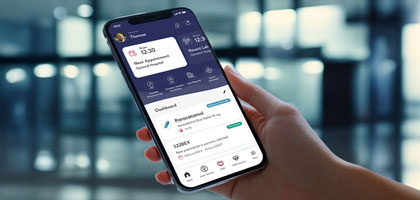
Blog
This Month in Healthcare IT: Remarkable e-Health News in July
Keeping up with the rapid advancements in healthcare IT is a demanding task but it's the road to becoming a leader in the sector. As sectoral leaders, we track the latest reports, new regulations, global trends and developments. We evaluate them as the backbones of ensuring our continuous progress and sustained leadership in healthcare IT.
Continuous learning is the underlying mission to redefine how healthcare technologies change efficient healthcare delivery approaches with proactive and preventive thinking. This blog series results from this vision, emphasizing critical healthcare IT developments.
Here are the top 11 news that have made a difference in the healthcare IT industry from July 2024:
1. The WHO European Region has launched a new network called the Strategic Partners' Initiative for Data and Digital Health (SPI-DDH.)

The WHO European Region has started the Strategic Partners' Initiative for Data and Digital Health (SPI-DDH), a coordinated network involving the 53 WHO Member States and critical partners in data management and digital health. SPI-DDH aims to address the challenges of digital health transformation by enhancing access to safe, affordable and patient-centered digital health technologies. The initiative will gather over 100 representatives from various sectors, including government, private industry and academia, to work on improving health data interoperability, equitable digital health access and public trust in digital solutions. Their primary focus will be accelerating digital health capacity, utilizing AI, promoting home-based care and establishing interoperability standards.
2. The European Commission has published the report titled 'Digital Decade 2024: eHealth Indicator Study,' which provides the most recent assessment results of patients' access to electronic health records across 29 countries.

The European Commission has examined the progress made by the 27 European Union (EU) Member States, Norway and Iceland, regarding the citizens' access to their electronic health records. In the report titled, 'Digital Decade 2024: eHealth Indicator Study,' regarding access to digital health data, countries are classified into four categories: beginners, followers, fast-trackers and trendsetters. Each country's situations are summarized based on various e-health indicators such as access to health data, personal health records, reports, results, e-prescription usage and other relevant metrics.
Source: https://digital-strategy.ec.europa.eu/en/library/digital-decade-2024-ehealth-indicator-study
3. Microsoft outage disrupts healthcare services after CrowdStrike update.

A Microsoft outage on July 19, caused by an update to CrowdStrike's Falcon software, disrupted healthcare services by disrupting the Microsoft systems offline. Physicians and other healthcare professionals had to work manually without mission-critical healthcare IT systems, such as electronic health records. CrowdStrike CEO George Kurtz apologized and said that the outage was not a security incident or cyberattack. Despite significant challenges, many affected healthcare systems started to back up and running days after a global IT outage.
Source: https://www.healthcareitnews.com/news/worldwide-it-disruption-disrupts-healthcare-delivery
4. The Australian Department of Health and Aged Care released its 'Aged Care Data and Digital Strategy 2024 – 2029' plan.

The Australian Department of Health and Aged Care has released a five-year strategy for aged care reforms. In this action plan, the Australian government envisions an aged care system for achieving the highest quality patient-centered care for older people through data and digital innovation. The strategy identified specific outcomes like security and access control, optimizing data collection and utilization with AI, building data and digital maturity and building a framework for interoperability.
Source: https://www.health.gov.au/resources/collections/aged-care-data-and-digital-strategy-2024-2029
5. The Health and Human Services (HHS) proposed the HTI-2 Rule to strengthen healthcare interoperability and opened it to public comment in the US.

The US Department of Health and Human Services (HHS) issued its long-awaited 'Health Data, Technology and Interoperability: Patient Engagement, Information Sharing and Public Health Interoperability' (HTI-2) rule and proposed it for public comment.
Building on the HT1-rule, HTI-2 emphasizes advanced interoperability to promote information sharing across the US among patients, healthcare providers, payers and population health authorities. Further, it focuses on improved population health response, real-time prescription benefits, value-based care, stronger security measures and the adoption of USCDI v4 by 2028. The rule is open for public comment for 60 days.
Source: https://www.healthit.gov/sites/default/files/page/2024-07/ONC_HTI-2_Proposed_Rule.pdf
6. Austria introduced its first e-Health strategy plan, defining healthcare digitalization objectives from 2024 to 2030.

Austria published its first e-health strategy framework, aiming to strengthen its e-health infrastructure with a nationwide strategy for the application of digital healthcare solutions. This consolidated plan defines objectives and activities for 2024 to 2030. As a vision paper, it has been coordinately created by the federal government, the federal states and the statutory social insurance bodies to describe the initiation, coordination, implementation and evaluation of digital developments.
The main objectives are enabling digital access to the healthcare system, telehealth prevention and healthcare solutions, further development of the population health telematics infrastructure (GTI), forming the central e-health components, establishing governance and healthcare-relevant registers, more substantial secondary use of health data, accessible innovations and stronger digital skills. Expanding the country's Electronic Health Record (ELGA) infrastructure, being able to make physician appointments via the new 1450 health line from 2026 and video consultancy services are some concrete examples of these targets.
7. The 'National Implementation Center Program' was launched to accelerate data modernization and data exchange for enhanced population health action in the US.

The Association of State and Territorial Health Officials (ASTHO), National Network of Public Health Institutes (NNPHI) and Public Health Accreditation Board (PHAB) have launched a $255 million 'Implementation Center Program,' funded by the US Centers for Disease Control and Prevention (CDC). The program aims to support public health agencies in modernizing their data systems. The program will offer technical assistance through four Implementation Centers by accelerating the adoption of the latest health information technology standards to improve data exchange, enhance response to health threats and promote health equity. These centers will directly support health departments connecting healthcare data to the public health ecosystem.
8. The WHO African Region issued the progress report on 'Framework for Implementing the Global Strategy on Digital Health' in Africa.

The WHO African Region published its progress report on the global digital health strategy (GSDH) in the African region. In 2023, the WHO Regional Committee for Africa adopted an e-health strategy to encourage its development and implementation across member states in the region. So far, 38 states (81%) have developed a national digital health strategy, mostly using WHO resources and guidance. According to the report, challenges persist, such as the expansion of siloed digital health systems, limited ICT infrastructure and the need for awareness of the importance of legislation for digital health. However, one of the most pressing issues is the need for awareness of the importance of legislation for digital health. This is a crucial area that requires immediate attention and action.
In its new recommendations, WHO stressed practices such as stronger support for the enabling environment for the safe and sustainable use of digital health technologies, more countries developing national digital health strategies and establishing multisectoral arrangements for implementation.
9. The Australian Digital Health Agency published the 'National Healthcare Identifiers Roadmap 2023-2028' to promote a connected health system.

The Australian Digital Health Agency released a five-year roadmap to boost the adoption of national healthcare identifiers across healthcare facilities. The National Healthcare Identifiers Roadmap 2023-2028 outlines steps to promote the use of healthcare identifiers, which are essential for identifying individuals, healthcare provider individuals and healthcare provider organizations within Australia's health system. The roadmap aims to integrate these identifiers into all health information exchanges and digital health projects, reduce patient identification mismatches and improve the management and privacy of health information.
The roadmap includes plans for legislative reforms, service improvements and technical updates. Key actions involve revising the Healthcare Identifiers Act, enhancing data matching and quality and improving the technical standards and operational processes. This effort is part of the broader National Healthcare Interoperability Plan 2023–2028, which seeks to establish a connected and interoperable health system by accurately and efficiently identifying individuals and providers across the Australian healthcare terrain.
10. PAHO introduced the concept of 'digitally smart health facilities' (DSHFs) in the Americas.

PAHO has introduced the concept of Digitally Smart Health Facilities (DSHFs) as a transformative approach to healthcare in the Americas. Detailed in an editorial by Dr. Jarbas Barbosa in the Pan American Journal of Public Health, DSHFs integrate digital infrastructure, devices and services into the design, construction or renovation of healthcare facilities. This framework utilizes technologies like the Internet of Things, AI, blockchain, mobile apps and telehealth to improve patient outcomes, enhance operational efficiency and support health system resilience.
Inspired by PAHO's Safe Hospitals initiative, DSHFs aim to expand access to care and optimize healthcare services through advanced digital solutions. The editorial highlights the critical role of information and communication technologies in maintaining healthcare accessibility. DSHFs promise benefits, including personalized care, reduced medical errors and improved efficiency using tools like electronic health records and telehealth platforms.
11. Australia's first integrated population health and clinical data platform, SMART-PH, launched.

Flinders University researchers started developing SMART-PH, the first integrated AI-driven population health and clinical data repository in Australia. They aimed to enhance population health surveillance and emergency response. This platform, supported by nearly $2 million in funding, has the potential to provide a unified digital infrastructure for real-time collaboration among healthcare authorities and facilities.
The project, planned for implementation and evaluation with South Australian partners between 2027 and 2029, seeks to overcome current data silos and improve the use of high-quality population health data. Increased quality of health data is one of the four key targets in Australia's Digital Health Blueprint for the next decade.

Recent news shows that the future of digitalized healthcare has the potential to transform how public institutions and healthcare providers enhance healthcare delivery and empower patients to achieve better health conditions. The time to act is now; clear action plans are needed to maximize this potential toward a healthier future.
At Tiga Healthcare Technologies, we stand ready to take immediate action with all relevant stakeholders, such as healthcare professionals, providers, public institutions and policymakers, on their healthcare IT journeys with innovative products. To address the growing need for healthcare interoperability and data exchange, exemplified by initiatives like the US Centers for Disease Control and Prevention’s (CDC) 'Implementation Center Program,' we present our Health Information Exchange (HIE) Viewer, enabling healthcare professionals to access electronic health records from any healthcare system.

We provide Personal Health Record (PHR) and Central e-Prescription Systems to address the growing demand for effective electronic health record usage and management. For instance, our solutions align with the European Commission's 'Digital Decade 2024: eHealth Indicator Study' Plan. Additionally, our Closer-Elderly Smart Home creates environments suited to aging populations, as stressed by the Australian government’s ‘Aged Care Data and Digital Strategy’ Plan. Our AI-driven Predis platform is an excellent solution for enhanced population health management, like the first integrated population health platform in Australia, SMART-PH. Still, these are just some examples of our leading products!
We know that one of the main issues the world focuses on is increasing the capacity to utilize healthcare IT technologies to address ever-evolving healthcare needs. This responsibility and vision are embodied in our comprehensive suite of future-proof solutions, encompassing Healthcare Interoperability, Patient Engagement, Prescription and Medicine Management, Population Health Management, Personalized Healthcare and Hospital Information System product families.
We build the future of healthcare IT by dreaming of what it should be and tirelessly working without giving up.
Let's shape the future together, as always!









